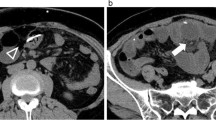Abstract
Introduction
The cyst-peritoneal shunt is a recognised surgical alternative in the management of sylvian fissure arachnoid cysts. Shunt overdrainage is well described in literature on ventriculo-peritoneal shunts, but not often appreciated as a complication of cysto-peritoneal shunts.
Case report
A 5-year-old boy presented with a symptomatic left sylvian fissure arachnoid cyst. This was initially treated by craniotomy and membrane fenestration in the carotid cistern. Recurrence led to insertion of a valveless cyst-peritoneal shunt 5 months later. Initial progress was followed by persistent headaches 18 months after shunt insertion. CT scan revealed a significant reduction in the cyst size, enlargement of the ipsilateral lateral ventricle, collapse of the contra-lateral ventricle and midline shift towards the side of the shunt. These findings were interpreted as over-drainage of the cyst-peritoneal shunt.
Result
A Codman Medos adjustable valve was inserted, with the intention of gradually increasing the pressure until the midline shift was restored and the contra-lateral ventricle was reconstituted. This was achieved with the valve set at 90 mm H2O, verified by CT scan. Radiological improvement was associated with dramatic symptomatic improvement.
Conclusion
Over-drainage of cyst-peritoneal shunts is often not appreciated, especially when the main manifestation is headaches. As it is difficult to predict the required valve pressure setting, it may be advisable to consider the use of an adjustable valve.



Similar content being viewed by others
References
Arai H, Sato K, Wachi A, Okuda O, Takeda N (1996) Arachnoid cysts of the middle cranial fossa: experience with 77 patients who were treated with cystoperitoneal shunting. Neurosurgery 39:1108–1112
Belliard H, Roux FX, Turak B, Nataf F, Devaux B, Cioloca C (1996) The Codman Medos programmable shunt valve. Evaluation of 53 implantations in 50 patients. Neurochirurgie 42:139–145
Ciricillo SF, Cofen PH, Harsh GR, Edwards MS (1991) Intracranial arachnoid cysts in children. A comparison of the effects of fenestration and shunting. J Neurosurg 74:230–235
Di Rocco C, Tamburrini G (2003) Shunt dependency in shunted arachnoid cyst: a reason to avoid shunting. Pediatr Neurosurg 38:164
Drake JM, Kestle JR, Milner R, Cinalli G, Boop F, Piatt J Jr, Haines S, Schiff SJ, Cochrane DD, Steinbok P, MacNeil N (1998) Randomized trial of cerebrospinal fluid shunt valve design in pediatric hydrocephalus. Neurosurgery 43:294–303
Germano A, Caruso G, Caffo M, Baldari S, Calisto A, Meli F, Tomasello F (2003) The treatment of large supratentorial arachnoid cysts in infants with cyst-peritoneal shunting and Hakim programmable valve. Childs Nerv Syst 19:166–173
Hopf NJ, Perneczky A (1998) Endoscopic neurosurgery and endoscope-assisted microneurosurgery for the treatment of intracranial cysts. Neurosurgery 43:1330–1336
Jain H, Sgouros S, Walsh AR, Hockley AD (2000) The treatment of infantile hydrocephalus: “differential pressure” or “flow-control” valves? A pilot study. Childs Nerv Syst 16:242–246
Lena G, Erdincler P, Van Calenberg F, Genitori L, Choux M (1996) Arachnoid cysts of the middle cranial fossa in children. A review of 75 cases, 47 of which have been operated in a comparative study between membranectomy with opening of cisterns and cystoperitoneal shunt. Neurochirurgie 42:29–34
Sgouros S, Chapman S (2001) Congenital middle fossa arachnoid cysts may cause global brain ischaemia: a study with 99Tc-hexamethylpropyleneamineoxime single photon emission computerised tomography scans. Pediatr Neurosurg 35:188–194
Sunami K, Saeki N, Sunada S, Hoshi S, Murai H, Kubota M, Takanashi J, Yamaura A (2002) Slit ventricle syndrome after cyst-peritoneal shunting for temporal arachnoid cyst in children—a clinical entity difficult to detect on neuroimaging study. Brain Dev 24:776–779
Zemack G, Romner B (2000) Seven years of clinical experience with the programmable Codman Hakim valve: a retrospective study of 583 patients. J Neurosurg 92:941–948
Author information
Authors and Affiliations
Corresponding author
Rights and permissions
About this article
Cite this article
Hamid, N.A., Sgouros, S. The use of an adjustable valve to treat over-drainage of a cyst-peritoneal shunt in a child with a large sylvian fissure arachnoid cyst. Childs Nerv Syst 21, 991–994 (2005). https://doi.org/10.1007/s00381-004-1072-6
Received:
Published:
Issue Date:
DOI: https://doi.org/10.1007/s00381-004-1072-6




